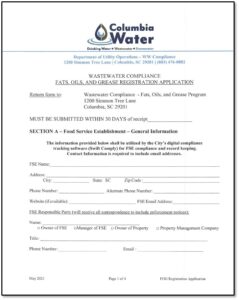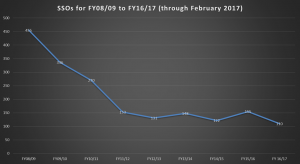Fats, Oils and Grease (FOG) cause problems with sewer systems, including the City of Columbia’s. When food particles, cleaning products and FOG flow to a sewer system, they can cause clogs that lead to sanitary sewer overflows, which can create environmental and public health concerns.
Columbia Water’s Commercial FOG Management Program enforces standards set under the City’s Sewer Use Ordinance for FOG-related discharges into the City’s sanitary sewers. Detailed requirements can be found in the City’s Engineering Regulations Part 29 and Part 30. The FOG Application can be found here or by clicking the image to the right.
Any business that regularly prepares food, whether for on-site consumption like restaurants and schools, or for late consumption, like grocery stores, has the potential to add FOG to our sewer system. Under Sewer Use Ordinance Sec. 23-117, these businesses need to make sure they have proper structures and procedures in place to prevent FOG from entering our sewers.
Food Service Establishments may want to consider using a responsible grease renderer to turn nuisance FOG into a usable, recycled product. Renderer’s service fees are often low, and in some cases, they may be willing to pay for restaurant oil and grease.


 . Keep this log on-site for 2 years. Keep the maintenance log up to date and readily accessible. This serves as a record of the cleaning frequency and can help the establishment manager optimize cleaning frequency to reduce costs.
. Keep this log on-site for 2 years. Keep the maintenance log up to date and readily accessible. This serves as a record of the cleaning frequency and can help the establishment manager optimize cleaning frequency to reduce costs. Yes. Through the commercial FOG program and the residential Trash the Grease campaign, Columbia Water has seen a drastic reduction in sewer overflows. In FY17-18 there were only three sanitary sewer overflows directly related to grease clogs.
Yes. Through the commercial FOG program and the residential Trash the Grease campaign, Columbia Water has seen a drastic reduction in sewer overflows. In FY17-18 there were only three sanitary sewer overflows directly related to grease clogs.